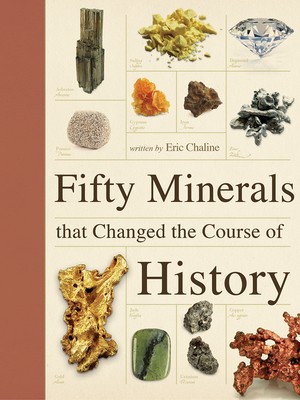
- We will send in 10–14 business days.
- Author: Eric Chaline
- Publisher: Firefly Books
- ISBN-10: 1770855874
- ISBN-13: 9781770855878
- Format: 17 x 22.6 x 2 cm, minkšti viršeliai
- Language: English
- SAVE -10% with code: EXTRA
Reviews
Description
The brief sections are consistently interesting, and plenty of supplemental illustrations and photos make this a handsome volume... best-suited to curious kids and casual mineralogists. --Publishers Weekly
A beautiful book, nicely bound and richly illustrated... written in an easy to read, casual style. --Science Books and Films
Fifty Minerals that Changed the Course of History is a beautifully presented guide to the minerals that have had the greatest impact on human civilization. These are the materials used from the Stone Age to the First and Second Industrial Revolutions to the Nuclear Age and include metals, ores, alloys, salts, rocks, sodium, mercury, steel and uranium. The book includes minerals used as currency, as jewelry and as lay and religious ornamentation when combined with gem minerals like diamonds, amber, coral, and jade.
Examples of the fifty minerals are:
Ubiquitous or rare, the minerals described in Fifty Minerals that Changed the Course of History have been fundamental to human progress, for good or evil. Many are familiar -- the aluminum can we drink from, the car we drive, the jewelry we wear. They can be poisons, medicines or weapons, but wherever found and however used, their importance can be easily overlooked. This attractive reference gives us fascinating insight into our undeniable dependence on minerals.
EXTRA 10 % discount with code: EXTRA
The promotion ends in 23d.15:06:41
The discount code is valid when purchasing from 10 €. Discounts do not stack.
- Author: Eric Chaline
- Publisher: Firefly Books
- ISBN-10: 1770855874
- ISBN-13: 9781770855878
- Format: 17 x 22.6 x 2 cm, minkšti viršeliai
- Language: English English
The brief sections are consistently interesting, and plenty of supplemental illustrations and photos make this a handsome volume... best-suited to curious kids and casual mineralogists. --Publishers Weekly
A beautiful book, nicely bound and richly illustrated... written in an easy to read, casual style. --Science Books and Films
Fifty Minerals that Changed the Course of History is a beautifully presented guide to the minerals that have had the greatest impact on human civilization. These are the materials used from the Stone Age to the First and Second Industrial Revolutions to the Nuclear Age and include metals, ores, alloys, salts, rocks, sodium, mercury, steel and uranium. The book includes minerals used as currency, as jewelry and as lay and religious ornamentation when combined with gem minerals like diamonds, amber, coral, and jade.
Examples of the fifty minerals are:
Ubiquitous or rare, the minerals described in Fifty Minerals that Changed the Course of History have been fundamental to human progress, for good or evil. Many are familiar -- the aluminum can we drink from, the car we drive, the jewelry we wear. They can be poisons, medicines or weapons, but wherever found and however used, their importance can be easily overlooked. This attractive reference gives us fascinating insight into our undeniable dependence on minerals.


Reviews